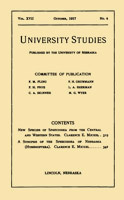University Studies of the University of Nebraska
Date of this Version
1-1905
Citation
UNIVERSITY STUDIES, Vol. V, No.1, January 1905.
Abstract
It is a familiar fact that new species appear from time to time among the native plants of a region. Such newcomers turn out on examination to be new only in the sense that they have not previously lived in the region, and in every instance these new plants are found to have come from other regions where they had existed for a longer or shorter period of time. In some cases the · new species remain for a time and then disappear, or at least become inconspicuous, but more commonly they crowd in among the former plants and become permanent members of the plant community. 'Whenever such an addition is made to the · flora of a region there is a readjustment of the former species, with a necessary change in the relative numbers of .the individuals, and the particular habitat of each. In the case of annual plants these adjustments are made rapidly, so that in a short time the prominent features of the plant community may be entirely changed. On the other hand, in the case of perennial plants there is greater stability, new species finding greater difficulty in entering, and the old species giving away, if at all, only after the lapse of a much longer time. A vegetation which is well rooted in the ground is much less easily disturbed than one whose roots live for but a single season and then abandon the particular plot of ground where they grow. Forests are therefore conservative plant communities, into which new species gain entrance with difficulty, and which change very slowly after such entrance has been effected. There is only one other plant community whose stability approaches that of the forest, namely, the grassy vegetation of the prairies and plains, which is composed of perennial-rooted grasses, sedges, and rushes. Where these form a close sod new species are almost wholly excluded, and but little change takes place in the character of the vegetation. It is only where the surface is not closely covered that the grassy vegetation is more easily modified by the incoming of new species. Where accident. or disease, or some other cause has destroyed the grassy covering new species promptly take possession. A fine example of this is to be seen in the growth of Helianthus annuus on the mounds made on the prairies by such burrowing animals as gophers and prairie dogs. Where the tough sod was broken by the freight-wagons which crossed Nebraska by various "trails" many years ago botanists find many newcomers, which could not have gained a foothold in the unbroken sod.

